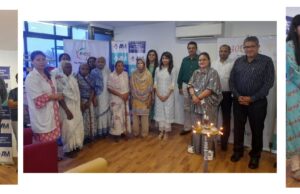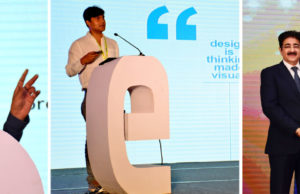
WoT's Hot
Canvassed Collectibles, an exhibition of more than 50 works by 13 artists which formed part of the Stadel Art Initiative was inaugurated by the Director of the Alliance Française du Bengale, Stephane Amalir. A double whammy was the display by Endless Possibilities of a range of linen and cotton sarees and dupattas and finely worked chikankari, at Mirage. EP is the new set-up jointly promoted by Rekha Bhutoria and Nishi Pant, aiming to bring new weaves, good art and more to cater to discerning tastes and also to revive and provide sustainable work opportunities for weavers.
At the inauguration, Stephane Amalir praised the city of Calcutta as the intellectual capital of India, and talked of how, during his five-year tenure, he discovered new galleries every month, and hosts of exhibitions and was amazed by the wealth of talent of artists in this part of the world. A sobering thought came from him when he pointed to the fact that it is a tough time for artists not only in India but in other parts of the world. For the many artists who are struggling to sell their art, and making a living out of it, he had the following comparison: “it is like an army of heroes who know that only a few of them will receive medals but who will continue to march against ignorance and against finance to offer their vision of a world in which profit-making is not the only target.”
Stephane Amalir recollected how, just recently French citizens had to choose between 11 candidates: none of these candidates had anything to say about culture or, in some cases, even about education. The themes of their electoral campaign, he mentioned, focused on the economy, security, mass unemployment and terrorism. “These are evidently serious issues but I think that ignoring art, culture and as I said, sometimes education is to ignore that a person’s life cannot be summarized by the bread on their table and the fence around their small garden.”
Indeed, art has always been the best tool for starting a dialogue of culture: to learn about the other’s culture is the first step to understand them, to respect their difference and even better to notice the similitude beyond the difference.” Also important was to educate children about art and other cultures to help them to appreciate that they are not unique, that they share with the person on the other side of the border the same need and necessity for the art, that the live in the same world.”
Much food for thought, just as the themes of the works of art had a lot of depth, color and variation to ruminate on.
Canvassed Collectibles, an exhibition of more than 50 works by 13 artists which formed part of the Stadel Art Initiative was inaugurated by the Director of the Alliance Française du Bengale, Stephane Amalir. A double whammy was the display by Endless Possibilities of a range of linen and cotton sarees and dupattas a
Other Articles in REAR WINDOW WOT
What to read next
Featured articles

Welcome Festive Season in Glam, Latin Quarters Launches new #PujoBling Collection with Monami Ghosh
by WOT













































